Plate or frame prosthesis
Plate or frame prosthesis
If one or more teeth need to be replaced
A plate or frame denture, also known as partial dentures, is a replacement of one or more (but not all) teeth. A good solution if your lost teeth are not replaced by a crown, bridge or implants. You can take the prosthesis out of your mouth; a crown, a bridge and implants are not. They are stuck in the mouth.
The plate prosthesis
The plate denture is made of a pink, gum-colored synthetic resin. The artificial teeth and molars are anchored in it. The prosthesis rests entirely on the mucous membrane of the mouth and may be attached to the remaining teeth with brackets.
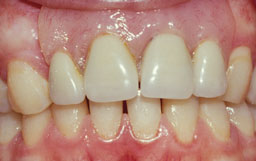
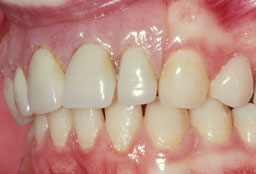
The frame prosthesis
The frame prosthesis has a metal base. A pink, gum-colored synthetic resin has been applied to the metal. The artificial teeth and molars are stuck in it. In contrast to the plate denture, the frame denture mainly rests on the remaining teeth and sometimes partly on the mucous membrane of the mouth. The frame prosthesis is attached to the teeth and/or molars with metal anchors that rest on the teeth and clamp around them with their anchor arms. The anchor arms are often somewhat visible.
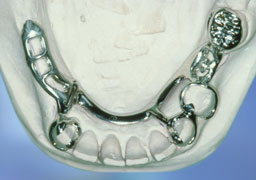
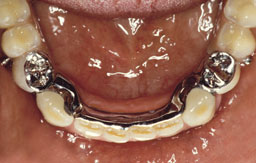
Differences between the plate and frame prosthesis
A plate prosthesis is cheaper than a frame prosthesis, but it also has disadvantages. The plate denture rests entirely on your gums and that can easily lead to gum problems because your gums have to absorb the forces caused by chewing or grinding. It is also easy for food to get stuck under the plate prosthesis. This quickly leads to inflammation of the gums.
A frame denture rests largely on your remaining teeth and to a lesser extent on the gums. As a result, your own teeth absorb the chewing forces and the gums are spared more than with a plate denture.
Which one is most suitable for you differs per person. You make the choice in consultation with your practitioner. Sometimes the dentist carries out the entire treatment; sometimes the dentist treats your own teeth and a dental technician makes the partial dentures.
Making a plate or frame prosthesis
Before a frame prosthesis is printed, supports usually have to be ground in your own teeth; this is usually not the case with a plate prosthesis. The dentist or dental prosthodontist then prints your jaws. This is done with the aid of an impression tray, filled with an impression material. The impression is then filled with plaster in a dental laboratory. This creates the plaster model on which your plate or frame prosthesis is made. Sometimes a second print is needed to get a nice print.
You need a total of four to five treatment visits to tailor and fit a plate prosthesis. All together it takes about five weeks. The frame prosthesis requires more visits and the customization usually takes several weeks longer.
The first days with a plate or frame prosthesis
A few days after the dentist or dental technician has placed the plate or frame prosthesis in your mouth, they will check the prosthesis. You may still talk a little awkwardly when you first wear the prosthesis. Some sounds sound a little different. This is normal and will pass on its own. You just have to get used to the prosthesis. If complaints persist, please contact your practitioner. If your prosthesis fits properly, the dentist will check it during the six-monthly check-up of your own teeth.
Cleaning a plate or frame prosthesis
Just like your own teeth, you should also keep your plate or frame dentures clean. If you do not clean them regularly, food residues and dental plaque will remain, both on your denture and under your denture. If you don't remove it, your gums can eventually become inflamed. Therefore, clean your dentures carefully after every meal. Use a special denture brush and soap and water to properly remove food residues and dental plaque. Do not use toothpaste. It can rub too much.
You do not clean your dentures with a denture cleaner; you do this, as mentioned earlier, with a denture brush and soap and water. You can, however, consider placing your denture overnight in a weakly-acting denture cleaning agent a few times a week. This prevents discoloration, caused by tea or red wine, for example, and the formation of tartar on your denture. Then brush your denture well and rinse it with water. Never place your denture in hot water and do not use aggressive denture cleaners and certainly not bleach or abrasives.
Of course you should also brush your own teeth carefully, otherwise you may lose even more teeth. Use a regular soft toothbrush and brush with fluoride toothpaste, which strengthens your teeth. Pay particular attention to the teeth on which your denture rests or against which your denture rests.
Clean your dentures daily with a cleaning agent available at the drugstore or pharmacy. Follow the manufacturer's instructions. If necessary, ask your practitioner or dental hygienist for advice. In any case, place your dentures in a cleaning agent overnight once a week. This prevents the formation of tartar on your dentures. Then brush your dentures well and rinse them with water. Never put your dentures in hot water and certainly do not use bleach or abrasives.
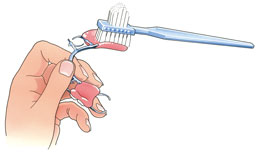
Do I have to take off the plate or frame prosthesis at night?
Some people grind their teeth in their sleep or press their teeth together tightly. This can put unnecessary pressure on the plate or frame prosthesis and the gums. In addition, the gums recover better at night if you remove the prosthesis. Talk to your dentist about what's best for you.
Do you not have the denture in your mouth? Then keep it in a glass of water. Change the water every day. You can also store the prosthesis in a glass filled with a cleaning agent. Always rinse the denture well with water before putting it back in your mouth.